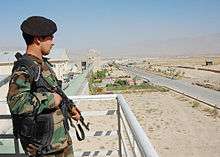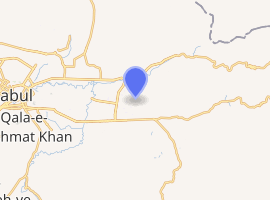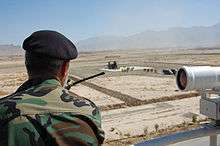Pul-e-Charkhi prison
Pul-e-Charkhi Prison (Pashto/Persian: زندان پل چرخی), also known as the Afghan National Detention Facility, is the largest prison in Afghanistan. As of 2018, it holds up to 5,000 inmates and is located east of Kabul.[1] Construction of the jail began in the 1970s by order of former president Mohammed Daoud Khan and was completed during the 1980s. The prison became notorious for torture and executions after the 1978 Saur Revolution as well as during the 10 year Soviet war that followed.[2] Some claim that between April 1978 and December 1979, the communist People's Democratic Party of Afghanistan (PDPA) under Nur Muhammad Taraki, executed around 27,000 political prisoners at Pul-i-Charkhi.[3] The Afghan National Army's 111th Capital Division is based near Pul-e-Charkhi prison.
 A guard assigned to the Afghan National Detention Facility watching over the perimeter of the compound. | |

| |
| Location | Kabul |
|---|---|
| Status | Operational |
| Security class | Maximum |
| Capacity | 14,000[1] |
| Opened | 1980s |
| Managed by | Ministry of Interior Affairs |
The prison has been renovated in recent years by the help of the United States Army Corps of Engineers. In 2007, the U.S. military began transferring some of its detainees from Bagram Air Base in Afghanistan to the Pul-e-Charkhi prison. By January 2008, as many as 125 detainees from the Parwan Detention Facility and 32 detainees from the U.S. Guantanamo Bay detention camp had been transferred to Pul-e-Charkhi.[4] This was followed by the transfer of some 250 more detainees.[5]
1978–1986
Mass grave
In December 2006, a communist-era mass grave, close to the Puli Charkhi prison, was discovered by the NATO-led International Security Assistance Force (ISAF). It is believed that the grave held some 2,000 bodies.[6][7][8][9] Officials of the Afghan Ministry of Information and Culture believe that the massacre took place between 1978 and 1986 when the Moscow-backed communist presidents, Nur Muhammad Taraki, Hafizullah Amin and Babrak Karmal were in power.
2001–present
Living conditions
Living conditions of the prisoners have been criticized by several human rights groups. The prison had been cited as overcrowded and the living conditions as sub-par. There had been eight cell blocks but only three were being used which has caused overcrowding.[10] There are also about 70 female prisoners who are housed in a special female section of the prison.
Riots and escapes
In December 2004, foreign prisoners attacked guards with razor blades. A subsequent shoot-out left one Iraqi and three Pakistani prisoners and four Afghan police dead.
In January 2006, seven prisoners escaped by mingling with visitors. A month later, a riot was sparked by a new prison policy forcing prisoners to wear bright orange clothing, a rule enacted to avoid events similar to the January escape. The February 2006 riot resulted in six deaths and 22 injured according to the International Committee of the Red Cross. The rioters used makeshift weapons to attack guards, then ignited furniture on fire, and smashed doors and windows. They eventually took over a wing of the prison and held it for a few days. The riot finally ended on the first of March.[11]
On 16 March 2008, after a two-week dispute over arrests following an attempted jail-break, inmates rioted and took over sections of the building. Gunfire was heard in the complex and inmates claimed to be holding hostage two members of the Afghan National Army (ANA). The hostage-takers threatened to kill the ANA members unless mediators were sent in to resolve the conflict.[12]
Renovation and expansion

The United States has repeatedly announced that it will be shutting down its Guantanamo Bay detention camps, in Cuba.[4] The Americans planned to transfer most of the captives held in extrajudicial detention in Guantanamo, and in its less well known Parwan Detention Facility to Afghan custody.
The initial plan called for reducing the maximum number of men held per cell from the current eight, to just two.[4] For security reasons every cell would be equipped with its own toilet, replacing the current insecure method of letting all the captives leave their cells and share a single toilet at the end of each cell-block.
Under this initial plan the modernization of this wing costed $20 million, and would have a maximum capacity of 670 captives.[4] However, after a tour of the facility, during its modernization, it was realized that, for cultural reason, captives could not be expected to share a toilet with another man. Afghan's cultural modesty would not allow a captive to use a toilet with another man present, cutting the capacity of the modernized facility in half.
On May 6, 2007, two American soldiers, Colonel James W. Harrison Jr. and Master Sergeant Wilberto Sabalu, part of the oversight team, were shot dead by one of the Afghan guards.[4] This forced a delay on construction as all the guards underwent new security checks. Finally, there was controversy within the Afghan government as to which ministry would be responsible for the modernized part of the prison.[4]
By January 2008, 32 captives from the Guantanamo Bay detention camp and 125 captives from the Parwan Detention Facility had been transferred to Pul-e-Charkhi.[4] The Center for Constitutional Rights reported that all of the Afghans repatriated to Afghanistan from April 2007 were sent to the Pul-e-Charkhi prison.[13]
In February 2009, a team from the United Kingdom's Channel 4 toured the American wing of the prison.[14] By September 2009 the United States had transferred some 250 former detainees from its Guantanamo Bay detention camp to Pul-e-Charkhi, often to the shock of their waiting families, according to Human Rights First (HRF).[5]
See also
References
- "US Funds Wastewater Treatment Facility at Pul-e-Charkhi Prison". TOLOnews. May 14, 2018. Retrieved 2019-05-16.
- Afghanistan: The Soviet Invasion and the Afghan Response, 1979-1982 M. Hassan Kakar. Berkeley, University of California Press, 1995. ISBN 0-520-20893-5 Prisoners of Pul-e-Charkhi
- Soldiers of God: With Islamic Warriors in Afghanistan and Pakistan by Robert D. Kaplan. Vintage, 2001. ISBN 1-4000-3025-0 p.115
- Tim Golden (January 7, 2008). "Defying U.S. Plan, Prison Expands in Afghanistan". New York Times. Retrieved 2008-01-07.
- "No Place Like Home". Archived from the original on 2011-09-16. Retrieved 2009-09-18.
- "Communist era mass grave discovered highlights need for post-war justice", IRIN, December 2002
- In pictures: Afghan mass grave BBC, July 5, 2007
- Kabul's prison of death
- "Hundreds of blindfolded bodies found in underground prison". Australian Broadcasting Corporation. 2007-07-06. Archived from the original on 2009-03-13. Retrieved 2009-03-13.CS1 maint: BOT: original-url status unknown (link)
- Pul-e-Charkhi Jail inmates face awful life
- Afghanistan: Who Instigated The Pol-e Charkhi Prison Riot And Why?
- Shooting Rocks main Afghan Prison BBC News 18 March 2008
-
"International Travel". Center for Constitutional Rights. 2008. Archived from the original on 2009-03-13. Retrieved 2009-03-13.
CCR attorney Pardiss Kebriaei traveled to Kabul to follow the situation of Guantánamo prisoners being returned to Afghanistan. Since April 2007, all such prisoners have been sent to a U.S.-built detention facility within the Soviet era Pule-charkhi prison located outside Kabul.
CS1 maint: BOT: original-url status unknown (link) - Nick Paton Walsh (2009-02-21). "Inside Afghanistan's 'Block D' prison". Channel 4. Archived from the original on 2010-02-11.
But we have learned of another secretive and controversial prison which is technically an Afghan jail where former inmates of Guantanamo and Taliban fighters are being held. Our correspondent Nick Paton Walsh has been to Block D in Kabul.
External links
| Wikimedia Commons has media related to Afghan National Detention Facility. |
- 6:30 REPORT: Drug Addiction In Pul-e-Charkhi Prison/گزارشِ ششونیم: مواد مخدر در زندان پُل چرخی on YouTube, March 10, 2017, TOLOnews.
- Inside an Afghan prison on YouTube, May 16, 2011, CBC News: The National.
- Afghan inmates compare Policharkhi to Guantanamo on YouTube, Jan. 24, 2009, Al Jazeera.
- Policharki riots
- "Militants take over Afghan prison wing in riot". Australian Broadcasting Corporation. 2006-02-26. Archived from the original on 2009-03-13. Retrieved 2009-03-13.CS1 maint: BOT: original-url status unknown (link)
- Human Rights First; Undue Process: An Examination of Detention and Trials of Bagram Detainees in Afghanistan in April 2009 (2009)
- Human Rights First; Arbitrary Justice: Trial of Guantánamo and Bagram Detainees in Afghanistan (2008)
- Lyse Doucet's (BBC Newsnight, Afghanistan) full film from inside Pul-e-Charkhi prison